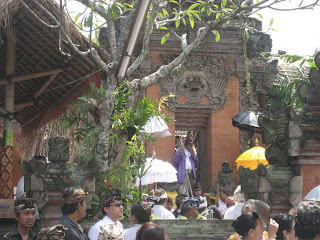
We met an Australian tourist who said that the food in Ubud is terrible -- the portions are small and the noodles are ramen. After almost a cumulative month of amazing gastronomy in Ubud, we all looked at each other in disbelief. We have no idea where this guy was taking his meals.
Ubud is the heart of Balinese art, music, and food. Smooth, sweet, homemade white brem (unfiltered sake-like rice wine) served on ice with lime, bubur injin (black rice pudding with coconut cream), bubur ayam or soto ayam (chicken rice porridge or chicken noodle soup), crepes filled with palm sugar and fresh coconut, lamek, and babi guling (roast suckling pig) kept us all ecstatically satiated.
Many of the restaurants offer cooking classes. We took a class at Casa Luna, owned and operated by Janet de Neefe, an Australian immigrant who married a Balinese and is raising their four children Balinese style. The couple owns a guesthouse and two restaurants. Janet has also authored a couple of books. I read Fragrant Rice, her biography, which also includes recipes.
Morning Market
Our cooking class included a trip to the market. The slimy, gelatinous green drink below, high in antioxidants and not unlike primordial soup, is popular with locals, especially as a morning pick-me-up.
Mangosteens, Yum!





























